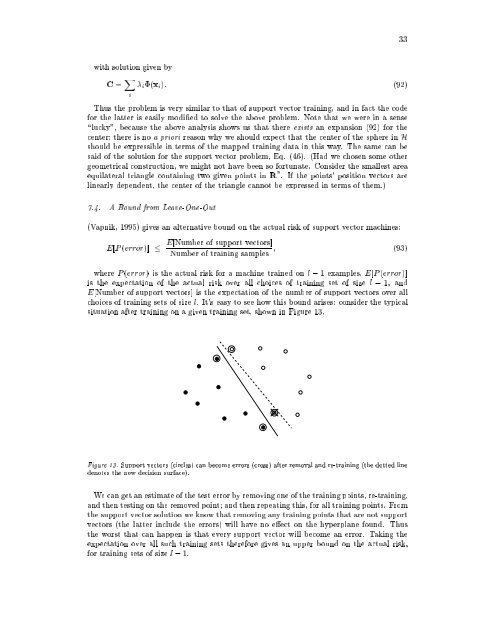A Tutorial on Support Vector Machines for Pattern Recognition
A Tutorial on Support Vector Machines for Pattern Recognition
A Tutorial on Support Vector Machines for Pattern Recognition
Create successful ePaper yourself
Turn your PDF publications into a flip-book with our unique Google optimized e-Paper software.
33with soluti<strong>on</strong> given byC = X i i (x i ): (92)Thus the problem is very similar to that of support vector training, and in fact the code<strong>for</strong> the latter is easily modied to solve the above problem. Note that we were in a sense\lucky", because the above analysis shows us that there exists an expansi<strong>on</strong> (92) <strong>for</strong> thecenter there is no a priori reas<strong>on</strong> why we should expect that the center of the sphere in Hshould be expressible in terms of the mapped training data in this way. The same can besaid of the soluti<strong>on</strong> <strong>for</strong> the support vector problem, Eq. (46). (Had we chosen some othergeometrical c<strong>on</strong>structi<strong>on</strong>, we might nothave been so <strong>for</strong>tunate. C<strong>on</strong>sider the smallest areaequilateral triangle c<strong>on</strong>taining two given points in R 2 . If the points' positi<strong>on</strong> vectors arelinearly dependent, the center of the triangle cannot be expressed in terms of them.)7.4. A Bound from Leave-One-Out(Vapnik, 1995) gives an alternative bound <strong>on</strong> the actual risk of support vector machines:E[P (error)] E[Number of support vectors]Number of training samples (93)where P (error) is the actual risk <strong>for</strong> a machine trained <strong>on</strong> l ; 1 examples, E[P (error)]is the expectati<strong>on</strong> of the actual risk over all choices of training set of size l ; 1, andE[Number of support vectors] is the expectati<strong>on</strong> of the number of support vectors over allchoices of training sets of size l. It's easy to see how this bound arises: c<strong>on</strong>sider the typicalsituati<strong>on</strong> after training <strong>on</strong> a given training set, shown in Figure 13.Figure 13.<strong>Support</strong> vectors (circles) can become errors (cross) after removal and re-training (the dotted linedenotes the new decisi<strong>on</strong> surface).We can get an estimate of the test error by removing <strong>on</strong>e of the training points, re-training,and then testing <strong>on</strong> the removed point and then repeating this, <strong>for</strong> all training points. Fromthe support vector soluti<strong>on</strong> we know that removing any training points that are not supportvectors (the latter include the errors) will have no eect <strong>on</strong> the hyperplane found. Thusthe worst that can happen is that every support vector will become an error. Taking theexpectati<strong>on</strong> over all such training sets there<strong>for</strong>e gives an upper bound <strong>on</strong> the actual risk,<strong>for</strong> training sets of size l ; 1.


